
|
Now it is very bright as 7.2 mag (Sept. 12, Maik Meyer). It stays bright as 7 mag until September. In the Northern Hemisphere, it will be observable in excellent condition. It will be getting higher gradually after this also in the Southern Hemisphere.
Date(TT) R.A. (2000) Decl. Delta r Elong. m1 Best Time(A, h)
Sept.15 6 7.99 25 1.9 0.395 1.015 80 6.9 4:17 (279, 59)
Sept.22 6 30.07 13 16.9 0.413 1.027 81 7.1 4:23 (299, 55)
|

|
It brightened up to 7.7 mag in June (June 19, Juan Jose Gonzalez). Now it is fading. But it is still bright as 9.8 mag (Sept. 10, Chris Wyatt). It stays bright as 9-10 mag for a while. In the Southern Hemisphere, it stays observable in good condition for a long time until the comet will fade out. In the Northern Hemisphere, it is not observable for a long time until autumn in 2019 when the comet fades out down to 16 mag.
Date(TT) R.A. (2000) Decl. Delta r Elong. m1 Best Time(A, h)
Sept.15 14 24.43 -59 38.0 2.355 2.249 71 9.6 19:32 ( 31,-21)
Sept.22 14 24.63 -60 30.9 2.451 2.265 67 9.8 19:22 ( 31,-23)
|

|
Now it is 12.2 mag (Sept. 11, Paul Camilleri). It will brighten rapidly, and it is expected to brighten up to 9 mag from autumn to winter. In the Northern Hemisphere, it stays observable in good condition for a long time until it fades out. In the Southern Hemispehre, it is observable in good condition until autumn, but it will be low in winter.
Date(TT) R.A. (2000) Decl. Delta r Elong. m1 Best Time(A, h)
Sept.15 5 16.76 9 20.9 1.374 1.742 92 11.2 4:17 (318, 58)
Sept.22 5 33.81 10 26.5 1.295 1.708 95 10.9 4:23 (323, 61)
|
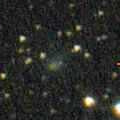
|
It brightened rapidly in outburst up to 6.9 mag (July 19, Maik Meyer). Then it faded down to 9.3 mag (Aug. 2, Katsumi Yoshimoto). It approached to Sun down to 0.2 a.u. in August, and it was expected to brighten up to 3 mag. However, it must have been already disintegrated. Now it is not observable. In the Northern Hemisphere, it will appear in the morning sky in late October. But it will be too faint to observe.
Date(TT) R.A. (2000) Decl. Delta r Elong. m1 Best Time(A, h)
Sept.15 11 37.29 11 43.7 1.882 0.900 8 10.9 19:32 (113,-11)
Sept.22 11 53.33 13 26.3 2.007 1.053 12 11.7 4:23 (246,-10)
|

|
It brightened in outburst on Aug. 14 up to 13.6 mag (Aug. 14, Piotr Guzik). It is bright as 12.5 mag still now (Sept. 11, Paul Camilleri). It is observable in excellent condition in the Northern Hemisphere. It stays low in the Southern Hemisphere.
Date(TT) R.A. (2000) Decl. Delta r Elong. m1 Best Time(A, h)
Sept.15 0 23.84 25 51.0 0.565 1.516 148 12.0 0:50 ( 0, 81)
Sept.22 0 26.04 28 25.7 0.528 1.485 150 11.7 0:25 ( 0, 83)
|
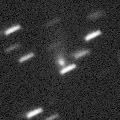
|
It brightened up to 8.7 mag in July (July 18, Marco Goiato). Now it is fading. But it is still bright as 12.3 mag (Aug. 29, Chris Wyatt). In the Southern Hemisphere, it is observable until September, but it locates in extremely low. In the Northern Hemisphere, it is not observable until late December.
Date(TT) R.A. (2000) Decl. Delta r Elong. m1 Best Time(A, h)
Sept.15 12 37.34 -30 5.8 1.985 1.327 36 11.7 19:32 ( 68,-22)
Sept.22 13 2.77 -29 25.0 2.135 1.419 34 12.2 19:22 ( 68,-20)
|

|
Now it is 10.5 mag (Sept. 1, Juan Jose Gonzalez). It will be fading slowly after this. In the Northern Hemisphere, it stays low until October. But it will be observable in good condition after that. In the Southern Hemisphere, it is not observable until summer in 2019.
Date(TT) R.A. (2000) Decl. Delta r Elong. m1 Best Time(A, h)
Sept.15 11 39.46 49 12.9 3.540 2.933 46 11.9 19:32 (141, 13)
Sept.22 11 59.02 48 22.4 3.545 2.967 47 11.9 19:22 (140, 13)
|

|
Now it is bright as 12.4 mag (Sept. 10, Juan Jose Gonzalez). It will approach to Earth down to 0.08 a.u. in December, and it is expected to brighten up to 3 mag. In the Northern Hemisphere, it stays observable in excellent condition. In the Southern Hemisphere, it is observable in good condition until mid December when it brightens up to 3 mag. But it becomes unobservable after that.
Date(TT) R.A. (2000) Decl. Delta r Elong. m1 Best Time(A, h)
Sept.15 1 44.40 -21 34.4 0.625 1.550 142 12.9 2:10 ( 0, 34)
Sept.22 1 49.15 -23 32.0 0.557 1.491 144 12.2 1:47 ( 0, 32)
|

|
Now it is 11.7 mag (June 12, Juan Jose Gonzalez). It is appearing in the morning sky. It stays 12 mag for a long time until spring.
Date(TT) R.A. (2000) Decl. Delta r Elong. m1 Best Time(A, h)
Sept.15 8 57.49 16 12.8 3.437 2.739 39 12.3 4:17 (264, 20)
Sept.22 8 59.33 14 19.4 3.364 2.757 45 12.3 4:23 (270, 25)
|

|
Now it is bright as 12.4 mag (Sept. 11, Paul Camilleri). It stays at 12-13 mag from summer to autumn. It is observable in excellent condition in the Southern Hemisphere. It locates somewhat low in the Northern Hemisphere.
Date(TT) R.A. (2000) Decl. Delta r Elong. m1 Best Time(A, h)
Sept.15 22 29.90 -28 32.7 1.083 2.022 150 12.9 22:52 ( 0, 27)
Sept.22 22 28.44 -28 46.9 1.125 2.030 144 13.0 22:23 ( 0, 26)
|

|
It approached to Earth down to 0.3 a.u., and brightened up to 8.3 mag in July (July 22, Juan Jose Gonzalez). Now it is fading. But it is still bright as 12.9 mag (Sept. 8, Chris Wyatt). It will go away from Earth after this, and will fade out rapidly. It will be getting lower after this. It will be unobservable in October.
Date(TT) R.A. (2000) Decl. Delta r Elong. m1 Best Time(A, h)
Sept.15 15 7.01 -8 14.3 1.779 1.462 55 12.9 19:32 ( 65, 18)
Sept.22 15 6.64 -7 42.2 1.977 1.511 48 13.3 19:22 ( 69, 16)
|

|
Now it is 15.6 mag (Sept. 11, Jean-Francois Soulier). However, Juan Jose Gonzalez reported it was 10.8 mag with a coma of 6 arcmin on Sept. 9.
Date(TT) R.A. (2000) Decl. Delta r Elong. m1 Best Time(A, h)
Sept.15 22 59.11 0 33.1 4.776 5.773 171 13.1 23:21 ( 0, 56)
Sept.22 22 56.06 0 17.5 4.796 5.772 165 13.1 22:51 ( 0, 55)
|
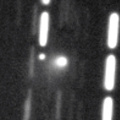
|
Now it is 13.9 mag (Sept. 3, Paul Camilleri). It stays at 14-15 mag for a long time from summer to winter. In the Southern Hemisphere, it will be getting lower rapidly after this, then it becomes unobservable after October. In the Northern Hemisphere, it stays observable for a long time until it fades out. But it stays extremely low.
Date(TT) R.A. (2000) Decl. Delta r Elong. m1 Best Time(A, h)
Sept.15 14 56.46 -7 12.6 2.435 1.991 52 13.9 19:32 ( 68, 17)
Sept.22 15 7.28 -5 51.4 2.464 1.947 48 13.9 19:22 ( 70, 17)
|
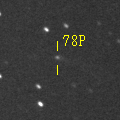
|
Now it is 14.9 mag (Aug. 8, Toshihiko Ikemura, Hirohisa Sato). It stays at 13 mag for a long time from winter to autumn in 2019. It stays observable in good condition until winter when the comet brightens up to 13 mag.
Date(TT) R.A. (2000) Decl. Delta r Elong. m1 Best Time(A, h)
Sept.15 21 24.57 -6 32.8 1.636 2.548 148 14.3 21:47 ( 0, 48)
Sept.22 21 21.68 -7 10.2 1.656 2.518 141 14.1 21:17 ( 0, 48)
|
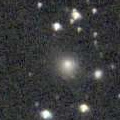
|
Now it is 14.0 mag (Sept. 6, Paul Camilleri). It stays 13-14 mag until summer in 2019. In the Northern Hemisphere, it stays observable in good condition for a while. It locates somewhat low in the Southern Hemisphere.
Date(TT) R.A. (2000) Decl. Delta r Elong. m1 Best Time(A, h)
Sept.15 16 17.98 16 6.6 3.642 3.463 71 14.2 19:32 ( 75, 47)
Sept.22 16 18.25 13 41.0 3.718 3.440 66 14.2 19:22 ( 75, 43)
|

|
Now it is 14.3 mag (Aug. 17, Ken-ichi Kadota). It will be observable at 12-13 mag for a long time from 2017 to 2018. In the Southern Hemisphere, it will be hardly observable after this. It becomes extremely low in September also in the Northern Hemisphere.
Date(TT) R.A. (2000) Decl. Delta r Elong. m1 Best Time(A, h)
Sept.15 11 51.34 36 29.5 4.956 4.156 33 14.3 19:32 (130, 7)
Sept.22 11 53.18 35 55.9 4.961 4.183 35 14.3 4:23 (229, 5)
|

|
Now it is 16.3 mag (Jan. 11, ATLAS-HKO, Haleakala). It will brighten up to 14 mag in winter. It will be observable in excellent condition in the Northern Hemisphere. It will be unobservable soon in the Southern Hemisphere.
Date(TT) R.A. (2000) Decl. Delta r Elong. m1 Best Time(A, h)
Sept.15 5 29.38 51 2.8 1.761 1.991 87 14.8 4:17 (220, 66)
Sept.22 5 49.51 54 19.6 1.697 1.978 90 14.7 4:23 (211, 66)
|

|
Now it is 15.1 mag (June 18, Martin Masek). It stays 15 mag from 2018 to 2019, and it will be observable for a long time in the Southern Hemisphere. In the Northern Hemisphere, it will never be observable again.
Date(TT) R.A. (2000) Decl. Delta r Elong. m1 Best Time(A, h)
Sept.15 13 41.67 -65 37.5 4.288 4.106 72 15.0 19:32 ( 27,-28)
Sept.22 13 58.47 -66 4.8 4.319 4.088 70 15.0 19:22 ( 27,-28)
|
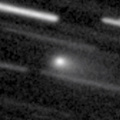
|
Now it is bright as 13.8 mag (Aug. 22, Thomas Lehmann). It stays observable in good condition for a long time after this. But it will be fading gradually.
Date(TT) R.A. (2000) Decl. Delta r Elong. m1 Best Time(A, h)
Sept.15 23 11.56 6 19.3 1.052 2.049 169 15.1 23:33 ( 0, 61)
Sept.22 23 5.71 6 3.4 1.099 2.087 166 15.4 23:00 ( 0, 61)
|

|
Now it is 16.4 mag (Aug. 17, Ken-ichi Kadota). It is observable at 15-16 mag in 2018, in good condition in the Southern Hemisphere. It locates somewhat low in the Northern Hemisphere.
Date(TT) R.A. (2000) Decl. Delta r Elong. m1 Best Time(A, h)
Sept.15 23 3.76 -19 54.7 2.347 3.319 162 15.4 23:26 ( 0, 35)
Sept.22 22 59.18 -20 7.0 2.391 3.333 156 15.4 22:54 ( 0, 35)
|

|
Now it is 14.0 mag (Sept. 11, Paul Camilleri). It will brighten up to 12 mag in autumn in 2019. It stays observable in good condition for a while in the Southern Hemisphere. In the Northern Hemisphere, it stays extremely low for a long time.
Date(TT) R.A. (2000) Decl. Delta r Elong. m1 Best Time(A, h)
Sept.15 2 58.59 -45 57.7 4.448 4.997 117 15.7 3:24 ( 0, 9)
Sept.22 2 52.12 -46 28.5 4.372 4.951 120 15.6 2:50 ( 0, 9)
|
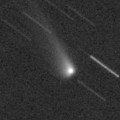
|
Now it is 16.3 mag (Aug. 18, Ken-ichi Kadota). Fading now. It stays observable in good condition for a long time after this in the Southern Hemisphere. It stays low in the Northern Hemisphere.
Date(TT) R.A. (2000) Decl. Delta r Elong. m1 Best Time(A, h)
Sept.15 23 54.08 -34 3.1 3.929 4.817 148 15.8 0:21 ( 0, 21)
Sept.22 23 43.73 -35 30.0 3.987 4.843 144 15.9 23:38 ( 0, 19)
|
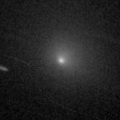
|
It brightened rapidly, and brightened up to 10.2 mag from May to June (May 22, Chris Wyatt). Now it is fading. It has already faded down to 13.0 mag (Aug. 20, Thomas Lehmann). It stays observable in good condition for a long time after this. But it will be fainter than 18 mag in October.
Date(TT) R.A. (2000) Decl. Delta r Elong. m1 Best Time(A, h)
Sept.15 0 42.75 -12 4.7 1.006 1.982 159 15.9 1:09 ( 0, 43)
Sept.22 0 32.13 -11 17.4 1.055 2.043 165 16.4 0:31 ( 0, 44)
|

|
It brightened up to 7.1 mag from May to June in 2017 (June 21, Juan Jose Gonzalez). Now it is fading. It has already faded down to 15.0 mag (July 15, Thomas Lehmann). In the Southern Hemisphere, it stays observable for a long time after this. It will never be observable again in the Northern Hemisphere.
Date(TT) R.A. (2000) Decl. Delta r Elong. m1 Best Time(A, h)
Sept.15 1 50.91 -54 3.2 4.796 5.392 121 16.0 2:17 ( 0, 1)
Sept.22 1 44.84 -54 28.2 4.860 5.453 121 16.1 1:43 ( 0, 1)
|
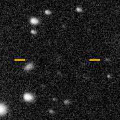
|
It will be observable at 16 mag in good condition from autumn to winter. It locates somewhat low in the Southern Hemisphere.
Date(TT) R.A. (2000) Decl. Delta r Elong. m1 Best Time(A, h)
Sept.15 7 3.29 29 35.2 2.539 2.359 68 16.5 4:17 (264, 49)
Sept.22 7 16.35 29 13.7 2.465 2.359 72 16.4 4:23 (267, 53)
|

|
It will brighten up to 13-14 mag in winter, and it will be observable in excellent condition.
Date(TT) R.A. (2000) Decl. Delta r Elong. m1 Best Time(A, h)
Sept.15 8 11.10 30 30.0 2.841 2.396 54 16.6 4:17 (255, 36)
Sept.22 8 26.23 30 16.1 2.751 2.373 57 16.5 4:23 (257, 40)
|
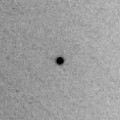
|
Now it is 16.2 mag (June 17, Jean-Francois Soulier). It stays 16 mag for a while. In the Northern Hemisphere, it stays observable in good condition after this until it fades out. It will be unobservable soon in the Southern Hemisphere. Its cometary activity was observed on Mar. 26 (M. Mommert, D. Polishook, N. Moskovitz).
Date(TT) R.A. (2000) Decl. Delta r Elong. m1 Best Time(A, h)
Sept.15 2 55.54 47 44.0 1.391 2.000 112 16.5 3:22 (180, 77)
Sept.22 2 48.06 49 56.8 1.393 2.059 117 16.5 2:47 (180, 75)
|
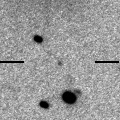
|
Now it is 16.8 mag (Aug. 8, Toshihiko Ikemura, Hirohisa Sato). It is expected to brighten up to 7-8 mag in 2020. In 2018, it will be observable at 15-16 mag in good condition from autum to winter.
Date(TT) R.A. (2000) Decl. Delta r Elong. m1 Best Time(A, h)
Sept.15 4 1.97 -4 32.0 6.124 6.571 112 16.6 4:17 (356, 50)
Sept.22 4 0.90 -4 45.8 5.974 6.513 118 16.5 3:59 ( 0, 50)
|
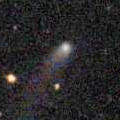
|
It brightened up to 14.7 mag in early 2018 (Jan. 25, Catalina Sky Survey). Now it is fading slowly. In the Northern Hemisphere, it stays observable in good condition for a long time until the comet fades out. It is never observable again in the Southern Hemisphere.
Date(TT) R.A. (2000) Decl. Delta r Elong. m1 Best Time(A, h)
Sept.15 8 16.95 53 16.5 6.134 5.760 63 16.5 4:17 (227, 41)
Sept.22 8 19.88 54 17.0 6.056 5.780 69 16.5 4:23 (226, 45)
|

|
Now it is 16.0 mag (Aug. 12, Gabor Santa). It will be observable at 16.5 mag in good condition from August to September.
Date(TT) R.A. (2000) Decl. Delta r Elong. m1 Best Time(A, h)
Sept.15 21 22.41 -6 28.2 1.178 2.100 148 16.8 21:45 ( 0, 49)
Sept.22 21 21.44 -6 53.2 1.196 2.076 141 16.9 21:17 ( 0, 48)
|

|
It brightened rapidly up to 11.1 mag (July 13, Chris Wyatt). Now it is fading. But it is still bright as 13.9 mag (Aug. 25, Ken-ichi Kadota). In the Southern Hemisphere, it stays observable in good condition all through this apparition. It became observable also in the Northern Hemisphere, but it stays low.
Date(TT) R.A. (2000) Decl. Delta r Elong. m1 Best Time(A, h)
Sept.15 0 39.56 -28 23.3 0.497 1.458 149 16.8 1:07 ( 0, 27)
Sept.22 0 20.46 -26 9.3 0.566 1.531 153 17.1 0:20 ( 0, 29)
|

|
Now it is 16.0 mag (Apr. 6, Sandor Szabo). It stays 16-17 mag for a long time until 2020. It is observable in good conditioin in the Northern Hemisphere. It is not observable at all in the Southern Hemisphere.
Date(TT) R.A. (2000) Decl. Delta r Elong. m1 Best Time(A, h)
Sept.15 10 8.20 67 23.1 8.866 8.501 65 16.9 4:17 (206, 30)
Sept.22 10 18.57 67 21.1 8.806 8.497 68 16.9 4:23 (207, 32)
|

|
First return of a new periodic comet which brightened up to 16.5 mag in 2005. Now it is 19.1 mag (June 14, E. Schwab, D. Abreu). It will be observable at 17 mag in good condition in autumn. It locates low in the Southern Hemisphere.
Date(TT) R.A. (2000) Decl. Delta r Elong. m1 Best Time(A, h)
Sept.15 1 56.18 35 26.7 1.287 2.068 128 17.2 2:22 (180, 89)
Sept.22 1 58.25 35 43.9 1.243 2.069 133 17.1 1:57 (180, 89)
|

|
Now it is 17.3 mag (Feb. 20, Toshihiko Ikemura, Hirohisa Sato). It stays 17 mag in 2018.
Date(TT) R.A. (2000) Decl. Delta r Elong. m1 Best Time(A, h)
Sept.15 5 12.74 4 6.3 7.439 7.577 94 17.2 4:17 (324, 54)
Sept.22 5 13.63 3 48.9 7.367 7.611 100 17.2 4:23 (337, 57)
|
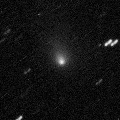
|
It brightened very rapidly up to 13.8 mag in last August (Aug. 22, 2017, , kunihiro Shima). After that, it is fading gradually. It has faded down to 15.9 mag in February (Feb. 13, Toshihiko Ikemura, Hirohisa Sato). In the Northern Hemisphere, it stays observable in excellent condition after this. It will be observable also in the Southern Hemisphere in December, but it stays low.
Date(TT) R.A. (2000) Decl. Delta r Elong. m1 Best Time(A, h)
Sept.15 8 48.74 28 59.2 2.916 2.334 46 17.2 4:17 (253, 28)
Sept.22 9 3.41 28 55.5 2.875 2.356 49 17.2 4:23 (255, 32)
|

|
Now it is 16.9 mag (Aug. 19, Toshihiko Ikemura, Hirohisa Sato). It will be fading gradually after this, and it will be fainter than 18 mag in winter. In the Northern Hemisphere, it stays observable in good condition for a long time. In the Southern Hemisphere, it will never be observable again.
Date(TT) R.A. (2000) Decl. Delta r Elong. m1 Best Time(A, h)
Sept.15 23 4.16 77 35.9 7.383 7.607 99 17.2 23:25 (180, 47)
Sept.22 22 56.71 77 16.3 7.365 7.634 101 17.3 22:51 (180, 48)
|

|
Now it is around the apheilon. But it brightened up to 15.8 mag in outburst (July 21, Hidetaka Sato). Now it is getting diffused. But it is bright as 16.2 mag still now (Aug. 18, Toshihiko Ikemura, Hirohisa Sato).
Date(TT) R.A. (2000) Decl. Delta r Elong. m1 Best Time(A, h)
Sept.15 20 55.32 -14 18.3 3.817 4.635 140 17.2 21:18 ( 0, 41)
Sept.22 20 53.48 -14 31.6 3.892 4.635 132 17.4 20:49 ( 0, 41)
|
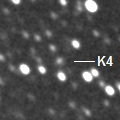
|
Now it is 17.8 mag (Aug. 8, Toshihiko Ikemura, Hirohisa Sato). It was observed at 16 mag from summer to autumn in 2017. It will be observable at 17 mag in good condition also in 2018. It locates somewhat low in the Southern Hemisphere.
Date(TT) R.A. (2000) Decl. Delta r Elong. m1 Best Time(A, h)
Sept.15 1 3.61 30 5.0 2.767 3.595 139 17.3 1:30 ( 0, 85)
Sept.22 0 59.76 30 7.3 2.765 3.639 145 17.4 0:59 ( 0, 85)
|

|
First return of a new periodic comet which brightened up to 17.5 mag in 2010. Now it is 19.0 mag (Aug. 10, Erwin Schwab). It is expected to brighten up to 16.5 mag from November to December. It is observable in excellent condition in the Northern Hemisphere. It locates low in the Southern Hemisphere.
Date(TT) R.A. (2000) Decl. Delta r Elong. m1 Best Time(A, h)
Sept.15 5 6.35 22 49.8 1.629 1.977 94 17.5 4:17 (302, 70)
Sept.22 5 18.52 23 45.6 1.557 1.969 98 17.4 4:23 (310, 74)
|

|
It was observed at 17 mag in last winter. It will be observable in good condition at 17.5 mag also in this winter.
Date(TT) R.A. (2000) Decl. Delta r Elong. m1 Best Time(A, h)
Sept.15 5 49.27 10 51.5 8.003 7.973 84 17.5 4:17 (305, 54)
Sept.22 5 47.83 10 26.5 7.884 7.978 91 17.5 4:23 (317, 59)
|

|
Return of a new periodic comet which brightened up to 17 mag in 2001. It was missed at the last return in 2010. Now it is 19.1 mag (Sept. 8, E. Schwab, D. Abreu). It was predicted to brighten up to 17.5 mag from September to November. But actually, it is a bit fainter than predicted.
Date(TT) R.A. (2000) Decl. Delta r Elong. m1 Best Time(A, h)
Sept.15 2 7.92 -13 39.4 1.331 2.197 139 17.7 2:34 ( 0, 41)
Sept.22 2 6.00 -13 47.5 1.294 2.193 145 17.6 2:04 ( 0, 41)
|

|
Now it is 17.7 mag (Aug. 8, Toshihiko Ikemura, Hirohisa Sato). It is expected to be observable at 5-6 mag for a long time from 2022 to 2023. It will be observable in good condition for a long time in the Southern Hemisphere. In the Northern Hemisphere, it is not observable at the highlight from 2022 summer to 2023 summer.
Date(TT) R.A. (2000) Decl. Delta r Elong. m1 Best Time(A, h)
Sept.15 17 8.10 57 5.1 13.283 13.221 84 17.8 19:32 (147, 60)
Sept.22 17 8.62 56 30.3 13.259 13.178 83 17.8 19:22 (143, 58)
|

|
First return of a new periodic comet which brightened up to 17 mag in 2008. It was predicted to brighten up to 18 mag in autumn. But actually, it is much fainter than predicted, fainter than 21.5 mag (June 22, Erwin Schwab).
Date(TT) R.A. (2000) Decl. Delta r Elong. m1 Best Time(A, h)
Sept.15 23 1.04 -1 5.2 2.818 3.817 172 17.8 23:23 ( 0, 54)
Sept.22 22 56.86 -1 20.2 2.837 3.816 165 17.9 22:51 ( 0, 54)
|

|
It was observed at 18 mag in last winter. It will be observable in good condition at 17.5 mag also in this winter.
Date(TT) R.A. (2000) Decl. Delta r Elong. m1 Best Time(A, h)
Sept.15 6 42.64 11 54.8 2.978 2.826 71 17.9 4:17 (290, 45)
Sept.22 6 51.09 11 11.7 2.902 2.835 76 17.8 4:23 (297, 49)
|

|
It has not been observed yet in this apparition. It will brighten very rapidly after this. It will brighten up to 14.5 mag from January to February, and it is expected to be observable in excellent condition.
Date(TT) R.A. (2000) Decl. Delta r Elong. m1 Best Time(A, h)
Sept.15 7 12.38 23 1.5 2.007 1.830 65 18.2 4:17 (271, 45)
Sept.22 7 31.18 22 14.4 1.924 1.801 67 17.9 4:23 (275, 48)
|
|
![]()
 C/2017 S3 ( PanSTARRS )
C/2017 S3 ( PanSTARRS ) 64P/Swift-Gehrels
64P/Swift-Gehrels C/2017 T3 ( ATLAS )
C/2017 T3 ( ATLAS ) C/2016 R2 ( PanSTARRS )
C/2016 R2 ( PanSTARRS ) 46P/Wirtanen
46P/Wirtanen C/2016 N6 ( PanSTARRS )
C/2016 N6 ( PanSTARRS ) 48P/Johnson
48P/Johnson C/2018 N1 ( NEOWISE )
C/2018 N1 ( NEOWISE ) 29P/Schwassmann-Wachmann 1
29P/Schwassmann-Wachmann 1 C/2018 L2 ( ATLAS )
C/2018 L2 ( ATLAS ) 78P/Gehrels 2
78P/Gehrels 2 C/2017 M4 ( ATLAS )
C/2017 M4 ( ATLAS ) C/2015 O1 ( PanSTARRS )
C/2015 O1 ( PanSTARRS ) (944) Hidalgo
(944) Hidalgo C/2017 B3 ( LINEAR )
C/2017 B3 ( LINEAR ) 37P/Forbes
37P/Forbes 65P/Gunn
65P/Gunn C/2018 N2 ( ASASSN )
C/2018 N2 ( ASASSN ) C/2015 V1 ( PanSTARRS )
C/2015 V1 ( PanSTARRS ) 66P/du Toit
66P/du Toit C/2015 V2 ( Johnson )
C/2015 V2 ( Johnson ) 59P/Kearns-Kwee
59P/Kearns-Kwee 123P/West-Hartley
123P/West-Hartley (3552) Don Quixote
(3552) Don Quixote C/2017 T2 ( PanSTARRS )
C/2017 T2 ( PanSTARRS ) C/2016 A1 ( PanSTARRS )
C/2016 A1 ( PanSTARRS ) 137P/Shoemaker-Levy 2
137P/Shoemaker-Levy 2 364P/2018 A2 ( PanSTARRS )
364P/2018 A2 ( PanSTARRS ) C/2010 U3 ( Boattini )
C/2010 U3 ( Boattini ) P/2018 L3 ( NEAT )
P/2018 L3 ( NEAT ) C/2011 KP36 ( Spacewatch )
C/2011 KP36 ( Spacewatch ) 240P/NEAT
240P/NEAT C/2014 OE4 ( PanSTARRS )
C/2014 OE4 ( PanSTARRS ) 129P/Shoemaker-Levy 3
129P/Shoemaker-Levy 3 C/2017 K4 ( ATLAS )
C/2017 K4 ( ATLAS ) P/2018 P1 ( Hill )
P/2018 P1 ( Hill ) C/2015 XY1 ( Lemmon )
C/2015 XY1 ( Lemmon ) P/2018 R1 ( LINEAR-Skiff )
P/2018 R1 ( LINEAR-Skiff ) C/2017 K2 ( PanSTARRS )
C/2017 K2 ( PanSTARRS ) P/2008 O2 ( McNaught )
P/2008 O2 ( McNaught ) 361P/2017 S4 ( Spacewatch )
361P/2017 S4 ( Spacewatch ) 60P/Tsuchinshan 2
60P/Tsuchinshan 2![]()
































